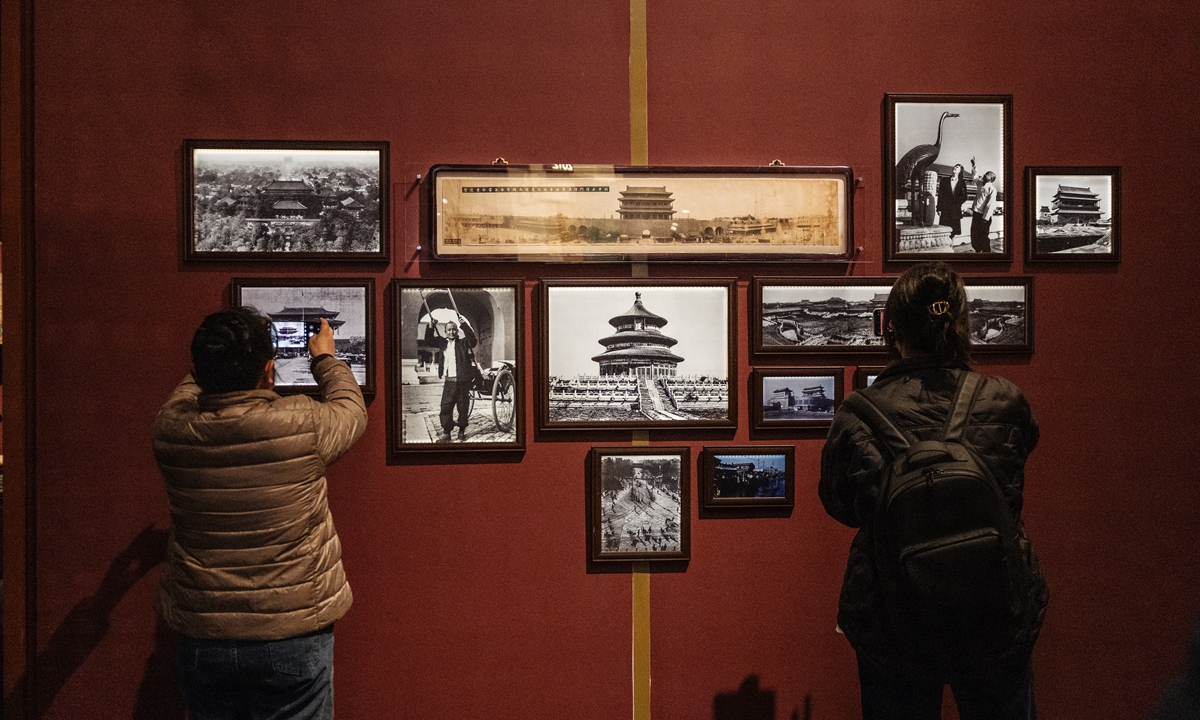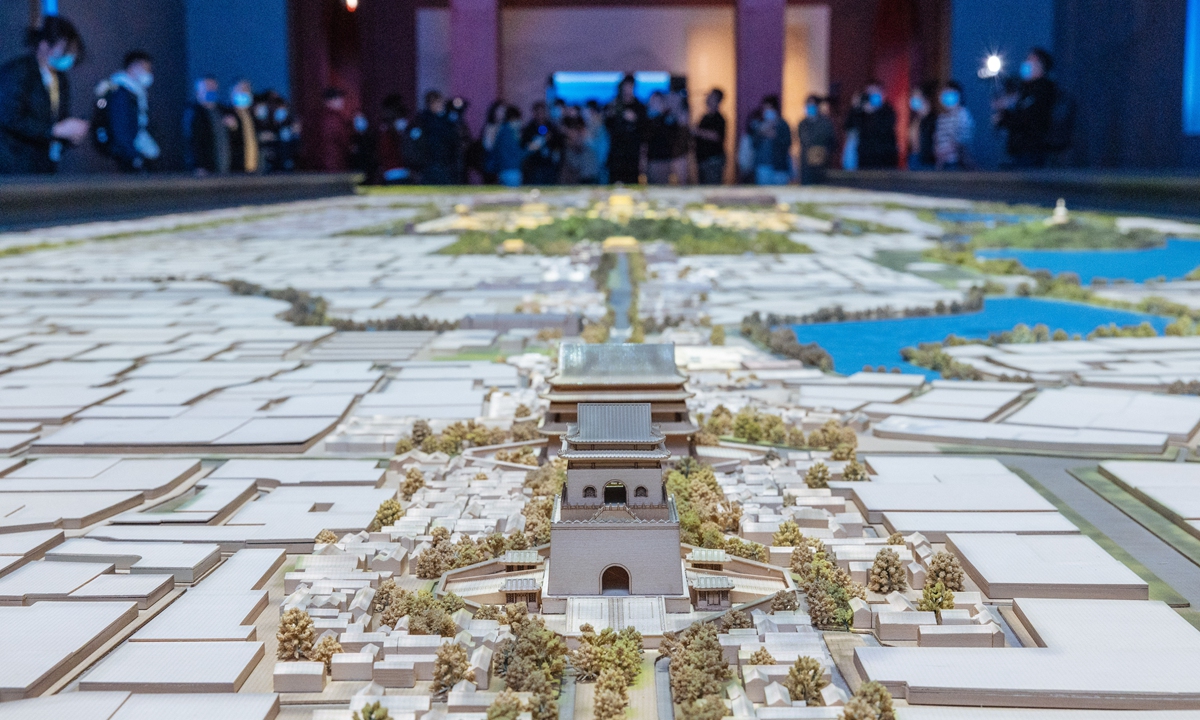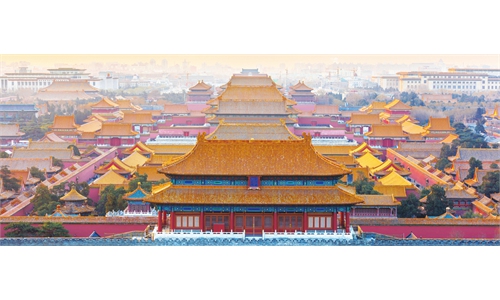ARTS / CULTURE & LEISURE
Beijing Central Axis exhibition celebrates the capital’s 870-year history
All encompassing legacy

Visitors take photos at the Beijing Central Axis Exhibition at the Capital Museum in Beijing. Photo: Li Hao/GT
A solemn hall dotted with starry lights and digital screens hanging on the walls, the Beijing Central Axis Exhibition kicked off on Tuesday at the Capital Museum with the aim of introducing to visitors the outstanding architecture of the core area of China's capital city.The exhibition celebrates the 870th anniversary of Beijing becoming China's capital city, while also carrying out the mission to elaborate on the significance of the Central Axis, a 7.8-kilometer-long area that runs through the center of the city from the Drum Tower and Bell Tower north of the Forbidden City to Yongding Gate in the south.
A total of 53 displays of cultural relics and paintings from 17 local cultural organizations including the Palace Museum give a full picture of the Beijing Central Axis.
The axis encompasses ancient imperial buildings such as the Forbidden City, as well as ceremonial and religious buildings such as the Temple of Heaven and historical boroughs like Qianmen.
What function does a central axis serve in Chinese cities and why do we tend to find one in most of China's ancient capitals?
"The appearance of a central axis is a reflection of our ancient Chinese ancestors' understanding of time and space, which is deeply rooted in our agricultural civilization," Deputy Director of the Capital Museum Showroom Zhong Mei explained to the Global Times.
"Our ancestors calculated time based on the movement of a shadow cast by the sun past a north-south line, which we call a meridian. Thus, the concept of the central axis was born and based on that our ancestors invented the 24 Solar Terms by observing the sky. These were used to track time and guide agricultural production for thousands of years," Zhong explained.
"Looking more deeply, we can still see traces of Chinese philosophy in the buildings along the axis, such as the concept of 'moderation,' as well as our pursuit toward social order. This is what we want our visitors to see here at the exhibition," said Zhong, who added that they spent three years preparing the exhibition.
Ancient urban design
The concept of a central axis is commonly seen in historical cities around the world. Other than the central axis in Beijing, the exhibition also showcases the axis in ancient Kyoto in Japan, which is said to have followed the blueprint of the ancient Chinese capital Chang'an (today's Xi'an in Northwest China's Shaanxi Province). The city axis in Paris took its form from the centuries-old Tuileries Gardens' center road, which can still be seen now across the city.
Even in a global scope, the central axes in China stand out with their unique pursuit of extreme symmetry and functionality.
To give a full picture, a 16-meter-long model of the Beijing Central Axis sits in the center of the exhibition so visitors can look at it from above.
The design of the city follows a strict pattern that was first recorded in the bureaucracy and organizational theory book The Rites of Zhou from the Warring States period (475BC-221BC) - boroughs sit on the north side of the city while temples for ancestor worship are to the west.
The story of the Beijing Central Axis began in 1153, when Wanyan Liang, fourth emperor of Jin (1115-1234) decided to move the dynasty's capital to Yanjing, as Beijing was known at the time. The move marked the first time Beijing was used as a capital of a dynasty.
"The city construction copied the planning and architectural style of Bianjing, the then-capital city of the Northern Song Dynasty (960-1127), now Kaifeng in Central China's Henan Province," introduced Zhang Wenyong, the exhibition curator and a researcher at the museum.

A 16-meter-long model of the Beijing Central Axis Photo: Li Hao/GT
Making progressOn August 7, 2022, China's National Administration of Cultural Heritage announced that the country would apply to have the Beijing Central Axis recognized as a UNESCO World Heritage Site in 2024, 10 years ahead of initial estimates - the original application was set for 2035.
Lü Zhou, director of the National Heritage Center of Tsinghua University, once told China Newsweek magazine that this heritage complex encompasses three World Heritage Sites, 11 national key heritage sites, as well as two municipal heritage sites.
"When so many heritages come together, the complex becomes a story of Chinese civilization and the process of unity in Chinese history, as well as a concise overview of Chinese aesthetics," Lü added.
As a world heritage candidate, the Beijing Central Axis also has its own competitive features, he noted.
"The core of this complex lies in its classic Asian urban planning, as well as its role as a legacy carrier of Confucian etiquette."
The application has entered the last few stages. It was submitted to the UNESCO World Heritage Center in February and a review by the International Council on Monuments and Sites will be launched this summer.
"For most visitors, the central axis is just a place where they go to visit as a tourist site without knowing its importance. Actually, it bears the embodiment of the ancient worship of Heaven and Earth in China," Zhong explained.

